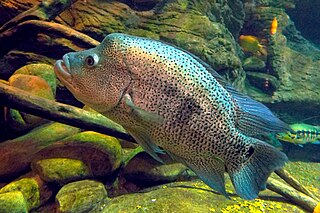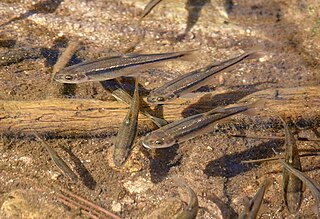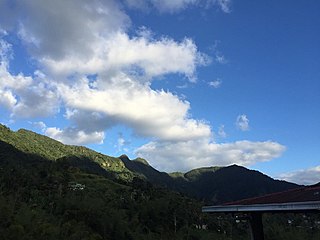
Mackerel is a common name applied to a number of different species of pelagic fish, mostly from the family Scombridae. They are found in both temperate and tropical seas, mostly living along the coast or offshore in the oceanic environment.

Herring are various species of forage fish, mostly belonging to the family of Clupeidae.

Sardine and pilchard are common names for various species of small, oily forage fish in the herring suborder Clupeoidei. The term 'sardine' was first used in English during the early 15th century; a somewhat dubious etymology says it comes from the Italian island of Sardinia, around which sardines were once supposedly abundant.

Parachromis managuensis is a large species of cichlid native to freshwater habitats in Central America, where it is found from Honduras to Costa Rica. The binomial name refers to Lake Managua in Nicaragua, from which the holotype was obtained. It is a food fish and is also found in the aquarium trade where it is variously known as the jaguar cichlid, managuense cichlid, managua cichlid, guapote tigre, Aztec cichlid, spotted guapote and jaguar guapote. In Costa Rica, it is known as the guapote tigre.

The elfin woods warbler is a species of bird endemic to Puerto Rico, where it is local and uncommon. Discovered in 1968 and described in 1972, it is the most recently described New World warbler.

Agonostomus is a genus of ray-finned fish in the family Mugilidae, the mullets. Considered to be the most primitive of the mullets, they are generally marine fish. The two members of the genus occur in the Indian Ocean.

The bobo mullet, is a species of ray-finned fish of the mullet family Mugilidae. It is the only species in the genus Joturus, one of 17 mullet genera containing altogether about 80 species of ray-finned fish. It occurs in rivers, including brackish waters, in much of the Gulf of Mexico basin from Mexico as far south as Panama and the Caribbean coast of Colombia, as well as the West Indies and the United States state of Florida. The specific name honours the Cuban lexicographer and geographer Esteban Pichardo (1799-1879).

Hypsophrys nicaraguensis, the moga, is a species of cichlid native to the Atlantic slope of Central America, from Nicaragua to Costa Rica. The species is a popular aquarium fish and is traded under a variety of common names that include nickie, parrot cichlid, macaw cichlid, butterfly cichlid, Nicaraguan cichlid and nicaraguense. In Costa Rica it is known as a vieja.

Parachromis dovii, the wolf cichlid, rainbow bass, or guapote, is a species of cichlid native to Central America, where it occurs in lakes, rivers and streams in Honduras, Nicaragua and Costa Rica. It is one of the largest cichlids, reaching up to 14 kg (31 lb) in weight and 80 cm (2.6 ft) long. A highly predatory species, it mostly feeds on other fish. P. dovii is important to local commercial fisheries, is sought after as a gamefish, and is sometimes kept in aquariums.

Agonostomus telfairii is a species of ray-finned fish in the family Mugilidae, the mullets. It is known by the common name fairy mullet. It is native to the islands off the eastern coast of Africa, where it can be found in freshwater bodies and estuaries in Comoros, Madagascar, Mauritius, Mayotte, and Réunion. It returns to the sea to spawn.
The scaleless killifish or Hazar toothcarp is a species of freshwater fish in the family Aphaniidae. It is the only species in its genus, and is endemic to Lake Hazar in Turkey. It is a pelagic species that comes to shore in spring–early summer to spawn. It is threatened by the falling water levels of Lake Hazar due to water abstraction and reduced rainfall due to climate change.

Toro Negro State Forest is one of the 21 forests that make up the public forests system in Puerto Rico. It is also Puerto Rico's highest cloud forest. It is in the Cordillera Central region of the island and covers 8,204 cuerdas, of mountains. Toro Negro's mountains have heights reaching up to 4,400 feet (1,300 m) and include Cerro de Punta, Cerro Jayuya and Cerro Rosa, the three highest peaks in the island. Nested among these mountains is Lake Guineo, the island's highest lake. The forest has 18 kilometers (11 mi) of trails, an observation tower, two natural swimming pools (Spanish:"charcos"), camping and picnic areas, nine rivers, and numerous creeks and waterfalls. The forest spans areas within the municipalities of Ponce, Jayuya, Orocovis, Ciales, and Juana Díaz, and consists of seven non-contiguous tracts of land. The largest contiguous segment of the forest is located in the municipalities of Ponce and Jayuya. Some 40% of the area of Toro Negro State Forest is located in Ponce's Barrio Anón.

An anchovy is a small, common forage fish of the family Engraulidae. Most species are found in marine waters, but several will enter brackish water, and some in South America are restricted to fresh water.

The longfin dace is a species of leuciscid fish found in western North America in the United States and Mexico. It is the only member of the monotypic genus Agosia. The Gila longfin dace is considered the nominate subspecies. The Yaqui longfin dace is considered as a form.
Stathmonotus gymnodermis, the naked blenny, is a species of chaenopsid blenny found in coral reefs from the Bahamas and Puerto Rico to coasts of northern South America, in the western Atlantic ocean. It can reach a maximum length of 4 centimetres (1.6 in) TL.

Pseudocaranx is a genus of ray-finned fishes from the family Carangidae, the jacks, trevallies, scads, and pompanos. They occur in the western Atlantic Ocean and the Indo-Pacific.

Atya lanipes is a freshwater amphidromous shrimp of the Atyidae family in the Decapoda order. It is found widely in the Caribbean and is common in the Toro Negro State Forest in central Puerto Rico. It is also known as jonga and in some places people refer to it as "guábara” or “chágara”.

Los Tres Picachos State Forest is one of the 20 forests that make up the public forest system of Puerto Rico. The forest is located in the Central Mountain Range or Cordillera Central, along the Los Tres Picachos mountain ridge, one of the island's highest mountains, named after the distinctive three peaks of the highest mountain in the forest. The state forest is located in the municipalities of Jayuya and Ciales.


















